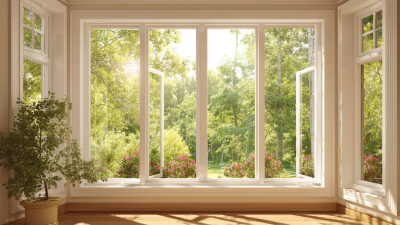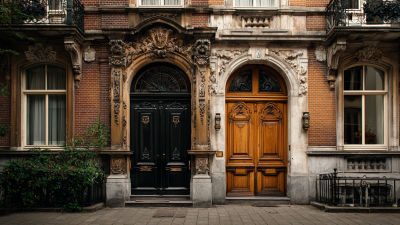Ultimate Guide to Selecting the Best Insulated Windows for Your Global Sourcing Needs
In today's energy-conscious world, the selection of high-quality insulated windows has become paramount for both residential and commercial projects. According to a report by the U.S. Department of Energy, approximately 25-30% of residential heating and cooling energy is lost through inefficient windows, highlighting the critical role insulated windows play in improving energy efficiency and reducing utility costs. Moreover, a study by the Efficient Windows Collaborative indicates that upgrading to properly designed insulated windows can lead to savings of up to 15% on energy bills. As global sourcing needs evolve, understanding the varying technologies and material options available for insulated windows is essential for architects, builders, and homeowners alike. This ultimate guide aims to equip readers with the necessary insights to make informed decisions, ensuring optimal performance and sustainability in their projects.

Table of Contents
[Hide]
Choosing the Right Insulated Window Materials: Key Considerations for Global Sourcing
When selecting insulated windows for global sourcing needs, understanding the materials used is paramount. The choice of materials not only affects thermal efficiency but also impacts durability, maintenance needs, and environmental sustainability. Common options include vinyl, wood, and fiberglass, each offering various benefits. Vinyl windows, for example, are energy-efficient and require minimal upkeep, while wood windows can provide superior insulation and aesthetic appeal. However, they may necessitate more maintenance over time.
Another key consideration is the window glazing – single, double, or triple-pane glass can significantly influence insulation performance. Double and triple glazing can reduce energy loss more effectively, making them ideal for regions with extreme climates. Additionally, sourcing insulated windows means considering certifications such as ENERGY STAR or NFRC ratings, which ensure quality and performance standards are met. By carefully evaluating these material options and certifications, you can ensure that your selection aligns with both performance and sustainability goals for your project.
Understanding the Energy Efficiency Ratings: How to Compare Window Insulation Performance
When selecting insulated windows for your global sourcing needs, understanding energy efficiency ratings is crucial. These ratings help compare window insulation performance, ensuring you make an informed decision. The National Fenestration Rating Council (NFRC) provides ratings for U-factor, Solar Heat Gain Coefficient (SHGC), and Visible Transmittance (VT). According to the U.S. Department of Energy, better-insulated windows can reduce energy bills by up to 25%, making energy efficiency a worthy investment.
Tip 1: Look for windows with a low U-factor, which indicates better insulating properties. A U-factor of 0.30 or lower is generally considered energy-efficient and can significantly improve a building's thermal performance.
Tip 2: Pay attention to the Solar Heat Gain Coefficient (SHGC). A lower SHGC means less solar heat is transmitted, which is particularly beneficial in warmer climates. For instance, a SHGC of 0.25 or below can help maintain indoor comfort without over-relying on air conditioning.
Tip 3: Consider the manufacturer’s performance data and warranties. A reliable company will provide comprehensive testing results to back their claims, ensuring that your investment in insulated windows results in long-term energy savings and comfort.
Evaluating Manufacturer Certifications: Ensuring Quality in Insulated Windows Global Supply Chains
When sourcing insulated windows for global supply chains, evaluating manufacturer certifications is crucial for ensuring product quality and reliability. Certifications such as ISO 9001, which focuses on quality management systems, signal that a manufacturer has established effective processes to meet customer and regulatory requirements. Additionally, certifications like ENERGY STAR indicate compliance with energy efficiency standards, which not only leads to better long-term savings for consumers but also reflects the manufacturer’s commitment to environmentally friendly practices.
Moreover, understanding the regional certifications that apply to insulated windows can provide further insight into a manufacturer’s credibility. For example, in Europe, the CE marking confirms that a product meets EU safety, health, and environmental protection standards. Collaborating with certified manufacturers not only mitigates risks associated with inferior products but also aids in maintaining a sustainable supply chain. By prioritizing manufacturers with strong certifications, businesses can ensure they are investing in high-quality insulated windows that will stand the test of time, thereby enhancing their brand reputation and customer satisfaction.
Cost vs. Quality: Balancing Budget Constraints with Performance in Insulated Windows
When selecting insulated windows for global sourcing, the challenge often lies in balancing cost with quality. According to the Efficient Windows Collaborative, energy-efficient windows can save homeowners between $126 and $465 per year on energy bills, depending on the climate and the type of window installed. This statistic underscores the long-term financial benefits of investing in high-quality insulation, even if initial costs are higher.
However, budget constraints are a reality for many businesses. The National Fenestration Rating Council (NFRC) states that high-performance insulated windows can cost 10-30% more than standard options. To navigate this, it’s essential to assess the life-cycle cost of windows, considering not just the purchase price but also installation and maintenance. For instance, choosing windows with higher R-values, which represent their insulation effectiveness, could result in reduced energy consumption and lower HVAC costs in the long run, ultimately offsetting the initial investment.
In addition, a report by the U.S. Department of Energy highlights that homes equipped with quality insulated windows can achieve up to 30% energy savings. Thus, while the upfront costs are an important factor, prioritizing performance through quality windows can lead to significant savings and enhanced comfort over time. By taking a strategic approach to window selection, businesses can achieve an ideal balance between cost and quality.
Sustainability in Insulated Window Production: Trends and Practices for Eco-Friendly Sourcing
Sustainability has become a critical consideration in the production of insulated windows, as both manufacturers and consumers seek eco-friendly sourcing options. Recent trends indicate a shift towards utilizing recycled materials in window frames and glazing. This not only reduces waste but also minimizes the carbon footprint associated with raw material extraction. Various companies are now adopting processes that enhance energy efficiency in manufacturing, ensuring that the entire lifecycle of the product aligns with sustainable practices.
Moreover, sustainable insulation practices extend beyond materials. Many manufacturers are investing in renewable energy sources, such as solar or wind power, to drive their production processes. This transition not only supports global sustainability goals but also reduces operating costs over time. Eco-friendly certifications and standards are increasingly vital for consumers striving to make informed choices about their purchases. As the market continues to evolve, businesses that prioritize sustainability in their sourcing strategies will likely find themselves leading the way in innovation and customer satisfaction.
Ultimate Guide to Selecting the Best Insulated Windows for Your Global Sourcing Needs
| Material Type | Thermal Performance (U-value) | Sustainability Certification | Recyclability | Average Cost per Unit |
|---|---|---|---|---|
| Vinyl | 0.25 | LEED Certified | Yes | $200 |
| Aluminum | 0.30 | Energy Star | Yes | $250 |
| Wood | 0.20 | FSC Certified | Yes | $300 |
| Fiberglass | 0.22 | Green Seal | Yes | $350 |
Related Posts
-

7 Secrets to Choosing the Best Energy Efficient Windows for Your Home
-

Innovative Examples of Energy Efficient Windows Transforming Home Energy Performance
-

Solutions for Boosting Energy Efficiency with Fiberglass Doors: Industry Insights and Data
-

What are the Benefits of Choosing Energy Efficient Windows for Your Home
-

Innovative Designs for Doors and Windows That Transform Spaces Globally
-

The Ultimate Guide to Choosing the Perfect Home Doors for Every Style and Budget